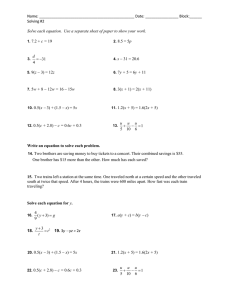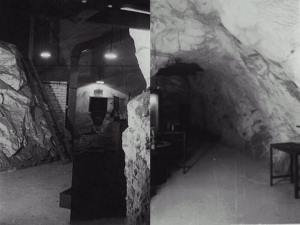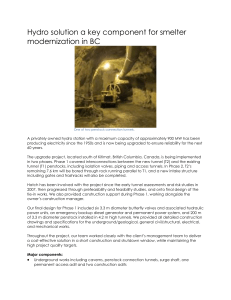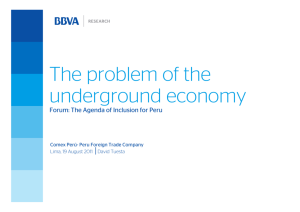Internal Flows, Metros and Underground Systems Reasons for this note
advertisement
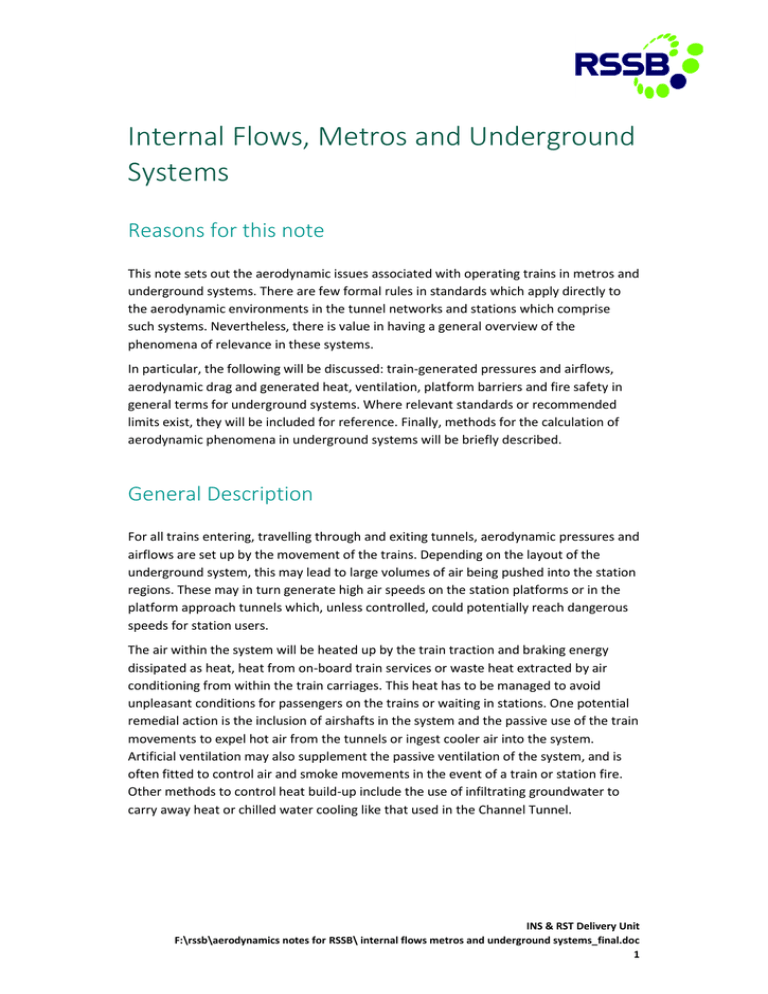
Internal Flows, Metros and Underground Systems Reasons for this note This note sets out the aerodynamic issues associated with operating trains in metros and underground systems. There are few formal rules in standards which apply directly to the aerodynamic environments in the tunnel networks and stations which comprise such systems. Nevertheless, there is value in having a general overview of the phenomena of relevance in these systems. In particular, the following will be discussed: train-generated pressures and airflows, aerodynamic drag and generated heat, ventilation, platform barriers and fire safety in general terms for underground systems. Where relevant standards or recommended limits exist, they will be included for reference. Finally, methods for the calculation of aerodynamic phenomena in underground systems will be briefly described. General Description For all trains entering, travelling through and exiting tunnels, aerodynamic pressures and airflows are set up by the movement of the trains. Depending on the layout of the underground system, this may lead to large volumes of air being pushed into the station regions. These may in turn generate high air speeds on the station platforms or in the platform approach tunnels which, unless controlled, could potentially reach dangerous speeds for station users. The air within the system will be heated up by the train traction and braking energy dissipated as heat, heat from on-board train services or waste heat extracted by air conditioning from within the train carriages. This heat has to be managed to avoid unpleasant conditions for passengers on the trains or waiting in stations. One potential remedial action is the inclusion of airshafts in the system and the passive use of the train movements to expel hot air from the tunnels or ingest cooler air into the system. Artificial ventilation may also supplement the passive ventilation of the system, and is often fitted to control air and smoke movements in the event of a train or station fire. Other methods to control heat build-up include the use of infiltrating groundwater to carry away heat or chilled water cooling like that used in the Channel Tunnel. INS & RST Delivery Unit F:\rssb\aerodynamics notes for RSSB\ internal flows metros and underground systems_final.doc 1 Pressures Just as in mainline railways, when trains enter and leave tunnels they generate pressure changes, also called pressure waves, a few percent above or below ambient atmospheric pressure. The strength of these waves depends on the train entry and exit speed, among a number of other influencing parameters. These pressure waves move along the tunnel at the speed of sound, reflecting at any interface with the open air or large volumes of air, such as at portals or at the top of airshafts and station voids. On reflection, the pressure waves are modified with waves above ambient pressure returning back into the tunnel as waves below ambient pressure and vice versa. This means that a train moves through a complex superposition of pressure changes as it travels through the tunnel. For mainline railways, these waves can superimpose to give relatively large positive or negative pressure transients. However, for underground railway systems, trains are travelling at much lower speeds and are generally either accelerating from station stops or decelerating into stations. This results in much smaller generated pressure waves. In addition, there are usually many different paths that pressure waves can take through the system, which tend to dissipate the pressures. The nett result is that pressure changes are generally very small and are not likely to be felt by train passengers or people waiting on the station platforms. Figure 1 shows predicted tunnel pressures in a London Underground Ltd (LUL) station and between two consecutive stations for a stopping strain travelling at a maximum speed of 80 km/h. Figure 2 shows the predicted pressures at the front and at the rear of a LUL 1967 tube stock train. The train leaves a first station at time 0 seconds, accelerates at 1 m/s2 until reaching 80 km/h at about 22.5 seconds, then travels at constant speed until 53 seconds before decelerating at 1.15 m/s2 and stopping at about 72 seconds in the next station. It then accelerates out of the station after a 30 second dwell time. 2 Figure 1: Predicted pressures in a LUL station (top) and in the tunnel between two consecutive stations (bottom). INS & RST Delivery Unit F:\rssb\aerodynamics notes for RSSB\ internal flows metros and underground systems_final.doc 3 Figure 2: Predicted pressures alongside a LUL tube stock train - A front, B rear. One of only two known pressure limit criteria for underground rapid transit systems was formulated by the USA’s Urban Mass Transportation Administration (UMTA), and is shown below. This consists of a maximum pressure change criterion and a second criterion related to the rate of change of pressures. A.1.3 - U.S. UMTA - Underground rapid transit systems Max. Change of pressure = 700 Pa within a 1.7 second period Max. Rate of change of pressure = 410 Pa/s (as an average rate over longer periods than 1.7 second) Operating conditions: - Low-speed operations: 80-100 km/h, - Unsealed rolling stock, - Tight bore tunnels, - Regular commuter customers. LUL [1] specifies that passengers should not be subject to pressure pulses exceeding 3 kPa and where pulses occur at regular intervals of less than 10 seconds, the maximum pulse should not exceed 0.45 kPa. Pressure variations caused by worst case combinations of train movements must nevertheless be considered in the design of fan ventilation systems. 4 Air flows The most noticeable aerodynamic effects caused by trains in underground systems are air flows. In single bore tunnels connecting stations air is pushed ahead of the train as it progresses through the tunnel, the so-called ‘piston effect’. Some of the air, and how much depends on the relative size of the train cross-sectional area to the tunnel crosssectional area, passes back alongside the train towards the tail. Air is then drawn along behind the train in the direction of train travel. Figure 3 shows a plan view of a computer model of a LUL station; (the vertical scale is exaggerated). Points C-F are located on the station platform, point G and H are located in passages connecting the two station platforms, point I is at the base of one escalator shaft and point J is located halfway up a second escalator. The approaching train in the tunnel is indicated by points A and B. The circles at each end of the platforms are air shafts. Figure 3: Prediction points within a model LUL station Figure 4 shows predictions of the air speeds at the points shown in Figure 3 within the station for the train scenario described for Figure 2. Points C-F are shown in the upper diagram, points G-J in the lower. It can be observed that as the train leaves the previous station air begins to flow along the station platform, with the highest air speeds occurring closest to the entrance to the station on the left (point C). The air speeds briefly drop to zero as the train enters the station and comes to a halt, before increasing to previous levels. The air speeds then decay as the train waits in the station, before increasing again as the train accelerates out of the station, this time the highest air speeds occur near the exit tunnel (point F). Meanwhile air escapes from the platform bore through into the other station platform bore, with quite high air speeds occurring in the cross passage close to the station entrance (point G). Air is drawn down one escalator (point J), but forced up the other (point I). At the latter point there is a peak in the airspeed as the train enters the station. There tend to be reversals of the flow directions once the train has entered the station and then leaves again. The air speeds in these passages are of a similar magnitude to those on the platform. INS & RST Delivery Unit F:\rssb\aerodynamics notes for RSSB\ internal flows metros and underground systems_final.doc 5 Figure 4: Predicted air flows within a LUL station Figure 5 shows the air speed at the mid-point between the two stations. The air speed gradually increases in the direction of train travel as the train enters and moves through the connecting tunnel, reaching a steady value of 15.8 m/s before the train passes, when it drops to about 3.9 m/s as the train passes. The air speed then increases again, becoming constant once more, until the train enters and stops in the station, when the air speed begins to decay towards zero. 6 Figure 5: Predicted air flows at the tunnel mid-point between two stations LUL [1] specifies that air velocities experienced by passengers during normal train operations should not exceed 5 m/s, and should be further limited to 3 m/s in stations areas where retail outlets are located. Aerodynamic drag and heat Trains experience increased aerodynamic drag as they travel through tunnels due to the work needed to overcome the air movements noted in Section 4, and the energy to overcome drag has to come from the traction energy of the train. Coupled with normal traction requirements to overcome mechanical resistance, and due to inefficiencies in the traction motors, this leads to the generation of heat. However, the frequent braking of the trains in the system tends to add considerably more heat into the system than that arising from just aerodynamic resistance. Figures 6 and 7 show the speed profile and predicted aerodynamic drag of the first train in a flight of six new design metro trains entering and passing eastwards at a maximum speed of 100 km/h through an underground system. A similar flight of trains enters the line from the westerly direction at the same time. There are five station stops during the journey. In this configuration the trains run in separate bores between the stations. INS & RST Delivery Unit F:\rssb\aerodynamics notes for RSSB\ internal flows metros and underground systems_final.doc 7 Figure 6: First train speed profile The leading train of the flight experiences the highest aerodynamic drag, (a comparison with the other trains is not shown), and the highest values occur between the stations, where the train reaches maximum speed. Figure 7: First train aerodynamic drag Ways in which the aerodynamic drag can be reduced include the use of double bore tunnels or connecting single bore tunnels with cross-passages or installation of airshafts. The first two permit the air to move more easily from the front to the back of the train, so reducing the overall aerodynamic drag of the trains. A disadvantage of these arrangements is that hot air tends to be retained in the system, gradually increasing in temperature during the day as the number of trains that have travelled in the system increases. Airshafts reduce drag by allowing air to be pushed out of or drawn into the system rather than through the system, and beneficially may aid cooling. 8 Other sources of heat in underground metro systems include: he passengers rain auxiliary equipment (including air conditioning if fitted) Services such as escalators and other equipment, commercial units and lighting in stations, The surface air in hot countries or in summer time when this air is drawn into the system. (In all cases, seasonal variations of ambient air temperatures have to be considered). In some parts of the world, e.g. Switzerland, there may also be geothermal heat to contend with. On the other hand, infiltrating water and the train structures themselves can provide mechanisms for the removal of heat, depending on their temperatures relative to the air in the underground system. The use of regenerative braking also reduces the amount of heat generated during braking. There are two timescales over which the heat balance in the tunnel system is important. One is the daily and seasonal temperature variations as they affect the passenger environment in the stations. The second is the long-term, (perhaps twenty to thirty years), when the local rock through which the system has been built gradually warms up before reaching a steady state temperature, reducing its capacity to take heat from the system. An analysis of the annual temperature variations in the tunnels of a particular underground system scheme showed that the approximate proportions of heat transfer were as follows: 1. Conduction to rock: 7% 2. Convection to the air: 65% 3. To train structure: 28%. An alternative heat balance is given in [2] for London Underground, and is shown in Table 1. INS & RST Delivery Unit F:\rssb\aerodynamics notes for RSSB\ internal flows metros and underground systems_final.doc 9 Table 1: Heat balance for London Underground [2]. Here the largest heat sink, loss of heat into the tunnel walls, is gradually reducing as the surrounding clay heats up. The large differences in the heat balance illustrated above indicate the complexity of heat management in underground systems, where local factors have to be taken into account and can have large effect. Ventilation Ventilation of underground systems is required to control the heat generated in the system for the reasons described above, and also to ensure the air quality for passengers at platforms and, in fire emergencies, help to control the movement of smoke. The latter will be dealt with in Section 8. 6.1 Normal ventilation LUL [1] requires that air temperatures in passenger areas should not exceed 30°C under normal operating conditions. LUL has relied on the use of airshafts located at stations and between stations for ventilation. The movement of trains in the system expels heated air above ground ahead of the trains, and then draws fresh and usually cooler air down the shafts into the system once the trains have passed the shafts. Fan ventilation is also applied to purge hot air from parts of the system. One potential difficulty with fan ventilation is the associated noise, and silencers may have to be fitted to control noise levels in tunnels or at ground level. Large scale air-conditioning of London Underground is not practical due to the cost and other methods have been suggested including cooling using ingress water and reengineering the existing ventilation system [2]. The heat in the tunnels is largely generated by the trains, with a small amount coming from station equipment and passengers. So addressing the heat generated by the trains at source can be very beneficial, as it is often much easier to manage the generation of heat than to remove it. Accelerating more rapidly and then using controlled coasting to the next station optimises energy usage. Controlled and firmer braking maximises energy recovery from regenerative brakes. 10 Usually, air conditioning of underground stations is neither a realistic nor economic method of cooling due to the large air volumes therein and the movement of air caused by the trains. However, local heat removal using under- or over-platform exhausts is often used to extract heat from auxiliary equipment on train roofs or from the braking units. 6.2 Trains stopped in tunnels Trains may be halted between stations because of congestion or operational difficulties. In these cases, heat is transferred to the tunnel from traction units, auxiliary equipment and passengers. Heat loss is at a peak when the trains first stop and the temperatures of the traction units are highest. For stopped trains the internal environment can rapidly become uncomfortable and unpleasant for passengers due to heat build-up, air quality degeneration, (in particular, carbon dioxide build-up from the respiration of the passengers themselves), and increase in relative humidity. There are a number of criteria and limits for these factors, either singly or in combination, and include the dry bulb temperature, the Relative Warmth Index, the Effective Temperature and the Wet Bulb Global Temperature. These criteria go beyond aerodynamic considerations and will not be considered further here, however, Pope et al [3] and Eckford[4] et al provide further details of these and some comparison between various of the criteria. Ventilation may be required to provide an appropriate airflow past a stationary train, for example using a push-pull technique. This is when fans in a shaft on one side of the affected train draw air downwards into the affected tunnel, whilst fans in another shaft located on the other side of the train suck air from the tunnel upwards. Platform barriers Platform barriers are increasingly used in underground rail systems to ensure the safety of passengers on the station platform who are waiting to board vehicles. The operation of the barriers is synchronised with the opening and closing of train doors and can assist in the management of station dwell times, permitting higher entry speeds for trains arriving at the stations. In tunnel networks, barrier installations may also be part of a continuous partition between the running tunnel and the station areas for the purposes of: Fire safety (including smoke management) Tunnel and station ventilation Trackside noise reduction Passenger comfort at climate controlled stations. INS & RST Delivery Unit F:\rssb\aerodynamics notes for RSSB\ internal flows metros and underground systems_final.doc 11 Having full height platform barriers means air will be pushed ahead of the trains in the running bores until the barriers are opened when the trains have stopped. In this way hot air is prevented from entering the stations in such large quantities, allowing the use of air conditioning on the platforms. Figure 8 shows full height platform barriers on the Shanghai Metro at University station. Platform barriers can also assist with the control of smoke in the event of a fire on a train and delay migration of smoke into the station platform and access passageways. Reduced height platform barriers are usually introduced for passenger control during overcrowding or to keep people away from the sides of trains and platform edge more generally, and are therefore safety devices. Depending on the details of their design, these barriers could have some beneficial aerodynamic effects, but the effects will be very much less than for full height barriers. Fire safety The issue of passenger safety in the event of fires in underground systems is treated very seriously during the design of metros. Consideration has to be taken of: the size and location of the fire (on a train/ in the running tunnels/ in the station areas); the procedures to evacuate passengers safely; ventilation and smoke control; train operations after the fire starts. There is evidence in the literature [5] that a flow speed of 3 m/s past a train on fire should be sufficient to keep smoke moving in the same direction as the ventilation flow. Local meteorological effects have to be considered to ensure that a forced ventilation system delivers the required air flow. Another consideration is to ensure that airflows generated in passenger walkways by the forced ventilation system do not exceed safe levels. It can be easily seen that a full fire safety analysis of an underground system is a large task. Figure 8: 12 Full height platform screen doors on the Shanghai Metro Prediction methods The previous sections demonstrate the extent of aerodynamic effects that have to be considered when designing and operating an underground system. Due to the complexity of such systems, they can only be analysed using computer programs. There are two main methods, one-dimensional analysis and computational fluid dynamics (CFD). 9.1 One-dimensional analyses One-dimensional analysis is extensively used in tunnel ventilation design. The software tools allow integrated modelling of the aerodynamic, thermodynamic and fire scenarios associated with underground system. One example is the Subway Environment Simulation (SES) program, developed by the United States Department of Transportation, Federal Transit Administration. This software allows the dynamic simulation of trains (piston effect), and predicts air velocity, temperature and humidity. The program also computes cooling and heating capacities required to satisfy environmental criteria, and the long-term effect of the system on the temperature of the surrounding strata. Ventilation systems consisting of fans, tunnels, stations and dampers can be modelled using the SES program. Input to the model includes details of plant, civil engineering details and the loads to be controlled by the ventilation system. Outputs from the model include air volume flow rates, pressure profiles and changes in air temperature caused by the heat output of the loads to be controlled. This program has been used extensively in the design of metro systems around the world. The Mott Macdonald rail tunnel aerodynamic and thermodynamic programs [6], using one dimensional analyses, form a suite of tools that have been used extensively by the company for designing metros systems around the world. The aerodynamic program models airflows using unsteady, compressible equations. Flows can be simulated in complex tunnel networks, with stations, airshafts and cross passages. Multiple train movements with force ventilation can also be modelled. The thermodynamics program uses outputs from the aerodynamic program to determine temperatures throughout the modelled tunnel network. Heat inputs from trains and other sources are included, together with any heat removal mechanisms. Time varying ambient conditions can also be taken into consideration. A third example of programs based on one-dimensional analysis is the THERMOTUN© software developed by Professor Vardy of Dundee University, [7]. This is based on a onedimensional representation of unsteady, homentropic, compressible flow. Parameters are considered constant across tunnel, station bore and passenger walkway crosssections. INS & RST Delivery Unit F:\rssb\aerodynamics notes for RSSB\ internal flows metros and underground systems_final.doc 13 Trains are regarded as impervious cylinders with constant cross-sectional areas. Local pressure loss coefficients can be specified at the front and rear of the trains to allow for flow separations or regions of different cross-sectional area, (e.g. locomotives or leading vehicle shaping). The values of such losses have to be determined experimentally from full-scale test or moving model tests. In open tunnel and in regions alongside trains, the equations of continuity, momentum and energy are combined and expressed in Characteristic form to enable the passage of pressure wave fronts to be simulated. Along each tunnel section account can be taken, if necessary, of variations in crosssectional area and elevation. There can be airshafts, with or without fans, and adjacent tunnels can be linked by cross-passages. Frictional effects due to tunnel walls and train surfaces are computed using friction laws for steady flow. Figure 9 shows a THERMOTUN© model of a typical underground station in plan, (the vertical scale is exaggerated), and in side elevation. Predictions can be made of pressures, air speeds, aerodynamic drag, pollution levels and temperatures anywhere on the trains and in the underground system, The main benefit of this program is the ease with which complex underground networks with multiple trains can be set up, and the speed with which the simulations run. A comparison of predictions with specially commissioned test pressure measurements made in the Victoria Line in London [8] is shown in Figure 10; the agreement is generally very good. Figure 9: 14 Figure 9 – THERMOTUN© underground station model Figure 10: Figure 10 – Comparison of predicted and measure pressures in a LUL station: P8 on station platform, P9 in northbound running tunnel, P10 in southbound running tunnel. 9.2 CFD methods CFD software is increasingly being used for aerodynamic predictions in railway tunnels as computer power increases and the cost of such applications reduces. CFD solves the fundamental equations of heat and mass transfer by approximating them by algebraic equations valid in very small volumes defined within the tunnel system. The latter equations are solved iteratively in each volume until solutions are found for the whole computational domain. Nevertheless, the complexity of underground systems and the requirement to solve transient equations to capture the effect of the moving trains means that only limited scenarios are currently modelled. References 1. London Underground Ltd. ‘Design of station and tunnel ventilation’, LUL Engineering Standard E 4064 A3, March 1998. 2. ‘Cooling the tube’, Rail Engineering, November/December 2007. 3. Pope, C.W., Pope, D.J. & Barrow, H. ‘Review of the environmental conditions inside an immobilized train in a tunnel’. International Railtech Congress ’98, Seminar: Tomorrow’s World, I Mech E Seminar Publication, National Exhibition Centre, Birmingham, UK, 24-26 November 1998. INS & RST Delivery Unit F:\rssb\aerodynamics notes for RSSB\ internal flows metros and underground systems_final.doc 15 4. Eckford, D.C. & Pope, C.W. ‘Cooling of underground railways’. Proc. 12th Int. Symposium on the Aerodynamics and Ventilation of Vehicle Tunnels, Portoroz, Slovenia, 11-13 July 2006, pp 409-424. Organised by BHRG, UK, 5. Henson, D.A. & Bell, R.J.W. ‘Planning and design of the ventilation system for the Vancouver advanced light rapid transit system’. Proc. 5th Int. Symposium on the Aerodynamics and Ventilation of Vehicle Tunnels. (Lille, France 20-22 May 1985), Cranfield UK, BHRA Fluid Engineering 1985, Paper K4, pp 605-618. 6. Henson, D.A. & Fox, J.A. ‘Transient flows in tunnels of the type proposed for the Channel Tunnel’. Papers 1 and 2, Proceedings of the Institution of Mechanical Engineers, Vol 188, 1974. 7. http://www.thermotun.com/ 8. Vardy, A.E. 'Unsteady airflows in rapid transit systems'. Proc IMechE, 194(32), 341-356, (1980). Bibliographic note The BHRA Group publish the ‘Aerodynamics and Ventilation of Vehicle Tunnels’ Conference Series, which contain many useful references to technical issues related to underground tunnel systems. Unfortunately, these are only available as bound symposia proceedings and individual papers are not available on the internet. More information can be found at http://www.bhrgroup.co.uk/confsite/infobook.htm. 16

